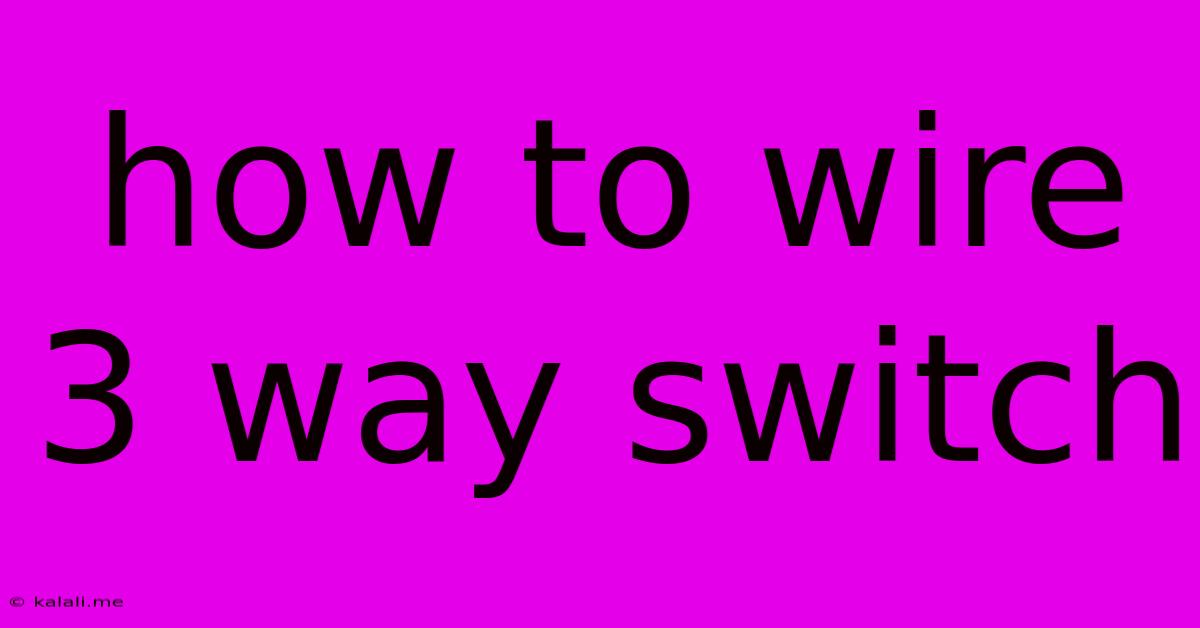How To Wire 3 Way Switch
Kalali
May 24, 2025 · 4 min read

Table of Contents
How to Wire a 3-Way Switch: A Comprehensive Guide
Meta Description: Learn how to wire a 3-way switch safely and effectively. This comprehensive guide covers everything from understanding the basics to troubleshooting common problems, making electrical work easier than ever before.
Wiring a 3-way switch allows you to control a single light fixture or other electrical device from two different locations. This is a common setup in hallways, staircases, and larger rooms. While it might seem daunting at first, with careful planning and attention to detail, wiring a 3-way switch is a manageable DIY project. However, always prioritize safety and turn off the power at the breaker box before starting any electrical work.
Understanding 3-Way Switch Wiring
Unlike a single-pole switch, a 3-way switch has three terminals instead of two. These terminals are usually identified as:
- Common Terminal: This is where the power comes in from the power source.
- Traveler Terminals: These are the two remaining terminals. They carry the power between the two 3-way switches. They are often identified with a different color screw or a slightly different position.
You'll need two 3-way switches and several wires to complete the circuit. Common wire colors include:
- Black (Hot): Carries the power.
- White (Neutral): Returns power to the power source.
- Red (Traveler): Connects the two 3-way switches.
- Black (Traveler): Connects the two 3-way switches (another traveler wire).
Important Note: Wire colors can sometimes vary, so always double-check your wiring diagram to ensure correct connections.
Step-by-Step Wiring Instructions
-
Turn off the Power: This is the most crucial step. Locate the breaker controlling the circuit you're working on and turn it completely off. Use a non-contact voltage tester to double-check that the power is off before proceeding.
-
Locate the Wiring: Access the existing wiring at both switch locations and the light fixture. If necessary, carefully remove the switch plates and junction boxes to expose the wires.
-
Connect the Wires at the First Switch Location: Connect the wires as follows:
- Black (Hot) wire from the power source: Connect to the common terminal of the first 3-way switch.
- Red (Traveler) wire: Connect to one traveler terminal on the first 3-way switch.
- Black (Traveler) wire: Connect to the other traveler terminal on the first 3-way switch.
- White (Neutral) wire: Connect to the neutral wire from the light fixture (or the neutral wire coming from the power source, if the neutral wire is not connected to the light fixture yet). Always cap and connect neutral wires together, keeping them isolated from the hot and traveler wires.
-
Connect the Wires at the Second Switch Location: Connect the wires as follows:
- Red (Traveler) wire: Connect to one traveler terminal of the second 3-way switch.
- Black (Traveler) wire: Connect to the other traveler terminal of the second 3-way switch.
- Black (Hot) wire going to the light: Connect to the common terminal of the second 3-way switch.
- White (Neutral) wire: Connect to the neutral wire from the light fixture.
-
Connect the Wires at the Light Fixture: Connect the black (hot) wire to the fixture, and connect the white (neutral) wire to the fixture. Secure all the wire connections using wire connectors.
-
Secure the Wiring and Install the Switches: Carefully tuck the wires back into the junction boxes. Install the 3-way switches and switch plates.
-
Turn the Power Back On: Turn the power back on at the breaker box and test the switches. The light should turn on and off from either switch location.
Troubleshooting Common Problems
- Light doesn't turn on: Double-check all wire connections. Ensure the power is on at the breaker box.
- Light flickers: This might indicate a loose connection or a faulty switch. Check all connections carefully.
- One switch doesn't control the light: Ensure the traveler wires are correctly connected at both switch locations.
Remember, if you are uncomfortable working with electricity, it's always best to consult a qualified electrician. This guide provides general information and should not be considered a substitute for professional electrical advice. Always prioritize safety and work carefully.
Latest Posts
Latest Posts
-
Can You Use 3 Way Switch As A Single Pole
May 24, 2025
-
What Is A Good Log Loss Score
May 24, 2025
-
Dracut Initqueue Timeout Warning Could Not Boot
May 24, 2025
-
You Do The Voodoo That You Do
May 24, 2025
-
Add Code To Wordpress Website Body
May 24, 2025
Related Post
Thank you for visiting our website which covers about How To Wire 3 Way Switch . We hope the information provided has been useful to you. Feel free to contact us if you have any questions or need further assistance. See you next time and don't miss to bookmark.